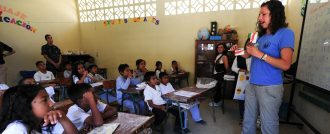Campus tours are a great way for prospective students and their families to get to know your school. Tours help them learn about the school’s mission and principles, see the inner workings of a class, and get all the information they need to decide which school is the best fit.
But for administrators, teachers, and current students, campus tours can be disruptive. Administrators need to strike a balance — find a way to give prospective students a memorable experience while protecting the learning environment for current students.
Pro Tip
Educators can easily organize campus tours with Jotform’s many online form templates. Try Jotform today!
Institute a campus visit program
Before successfully planning a campus tour, the admissions staff needs to lay the groundwork for the admissions process as a whole. Campus tours are crucial to enrollment, says Sujoy Roy, founder of VisitDays — but they’re only one step in the admissions process.
There are several ways for prospective students and their parents to get to know a school before stepping into a classroom. The college preparatory private school Francis Parker in San Diego offers hour-long coffee meetings, open houses, and visitor days in addition to campus tours. These alternative processes allow visitors to talk to school staff without disrupting normal classes.
Schools need to determine when it’s appropriate for parents to take part in alternative activities and when full campus tours are the better option. Schools may offer a range of informational nights and opportunities for parents of future students or let parents participate in tours once they have completed other steps in the admissions process — such as attending a preliminary informational meeting.
Each school has a different approach, Stacy Jagodowski at ThoughtCo explains. “Some schools have a block of time where prospective families can come and go, meet the admissions team, and take a quick tour, while others offer full programs that require families to register in advance and arrive by a specific time.”
These preliminary steps act as an introduction to the institution. Families of prospective students can learn the basics of the school, including costs and requirements for admission, and then decide whether or not they want to continue with the admissions process. This reserves campus tours for families dedicated to sending their child to the school in question.

Plan campus tours
One way to organize campus tours is by scheduling them as a regular part of the school calendar, with designated days for tours throughout the year. These dates must be accessible on the school’s website and at school meetings. Campuses can use online forms for parents to request admissions information and register for tours, reducing the number of email exchanges, calls, and drop-ins involved in the process.
Once parents have signed up for a campus tour, clearly communicate the itinerary and expectations. This information should appear on the school website, be emailed to participants, and given to visitors when they arrive.
Outlining behavioral expectations is crucial for minimizing disruption. When visitors are allowed into a classroom, they need to understand the rules. Schools can ask that visitors respect the classroom environment by not interrupting the teacher or engaging with the students unless prompted to.
Teachers can set up assigned seats for visitors and ask them to not touch any classroom materials. When these expectations are communicated online and in person, visitors will know how to behave appropriately, helping to ensure that your campus runs smoothly during tours.
Keep teachers involved
Communication isn’t limited to campus visitors. Teachers need to be involved in the planning process because it’s their class that will be most affected by observers. Communicating with teachers and allowing them to have a voice in deciding when groups visit their classroom will build trust and respect between teachers and the administration.
Trevor Muir, teacher and author of The Epic Classroom, says trust between teachers and principals is the key to building a strong school. “Teachers need to feel like they can give input on decisions that affect them and their work,” he writes.
Only teachers know when students will be taking tests, doing group work, or participating in a class activity that could demonstrate core teaching principles to onlookers. That’s why successful classroom tours cannot be implemented without the support of teachers.
By using online signup forms for classroom visits, teachers can control when groups will be able to visit and participate with their class. Online forms can also automate scheduling and empower teachers to be more directly involved in the admissions process.

Reduce disruption with virtual tours
In addition to browsing university websites and reading student blogs, students can now also take an interactive virtual campus tour from the comfort of their home. O’rya Hyde-Keller at Brown University writes that Brown’s virtual tours give future students the opportunity to get a feel for campus life without having to travel.
Virtual tours can benefit schools by reducing the amount of foot traffic on campus, while also improving enrollment rates. Public universities use virtual tours to boost enrollment from out-of-state and international students, says Jeff Soriano, VP of marketing at YouVisit.
Virtual tours are now becoming part of a normal part of recruitment and can be used as a powerful tool for admissions directors. Offering virtual tours is the most effective way of reducing class disruptions because it allows visitors to closely observe campus without entering a classroom.
Don’t forget to communicate
Class tours are an exciting way to connect with future students and families — but they’re only beneficial if they don’t distract teachers and current students from their classes.
Software tools like shared calendars, digital forms, and virtual tours are useful for planning and implementing campus tours, as long as there’s communication between everyone involved.
Make sure you communicate clearly with your admissions team, school administration, security, teachers, students, and visitors about how to plan campus tours that effectively showcase your school.






































































































Send Comment: